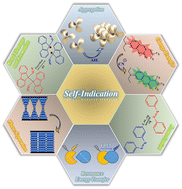Self-indicating polymers: a pathway to intelligent materials
Abstract
Self-indicating polymers have emerged as a promising class of smart materials that possess the unique ability to undergo detectable variations in their physical or chemical properties in response to various stimuli. This article presents an overview of the most important mechanisms through which these materials exhibit self-indication, including aggregation, phase transition, covalent and non-covalent bond cleavage, isomerization, charge transfer, and energy transfer. Aggregation is a prevalent mechanism observed in self-indicating polymers, where changes in the degree of molecular organization result in variations in optical or electrical properties. Phase transition-induced self-indication relies on the transformation between different phases, such as liquid-to-solid or crystalline-to-amorphous transitions, leading to observable changes in color or conductivity. Covalent bond cleavage-based self-indicating polymers undergo controlled degradation or fragmentation upon exposure to specific triggers, resulting in noticeable variations in their structural or mechanical properties. Isomerization is another crucial mechanism exploited in self-indicating polymers, where the reversible transformation between the different isomeric forms induces detectable changes in fluorescence or absorption spectra. Charge transfer-based self-indicating polymers rely on the modulation of electron or hole transfer within the polymer backbone, manifesting as changes in electrical conductivity or redox properties. Energy transfer is an essential mechanism utilized by certain self-indicating polymers, where energy transfer between chromophores or fluorophores leads to variations in the emission characteristics. Furthermore, this review article highlights the diverse range of applications for self-indicating polymers. These materials find particular use in sensing and monitoring applications, where their responsive nature enables them to act as sensors for specific analytes, environmental parameters, or mechanical stress. Self-indicating polymers have also been used in the development of smart materials, including stimuli-responsive coatings, drug delivery systems, food sensors, wearable devices, and molecular switches. The unique combination of tunable properties and responsiveness makes self-indicating polymers highly promising for future advancements in the fields of biotechnology, materials science, and electronics.



 Please wait while we load your content...
Please wait while we load your content...